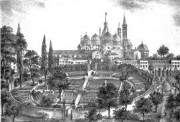|
|
City Map
Brief City’s History
The first inhabitants of Mantua, in 2000 BC, were probably the Umbrians . Later on, in 600 BC, the Etruscan people settled there and remained until 214 BC, the year of the Roman conquest of the City. At that time, Mantova was proclaimed a ” Free City ” thanks to the Giulio’s Law ( 90 BC). The Roman legions lived in Mantua until the barbarian invasions . The barbarian domain lasted for many centuries and in Italy took turns many barbarian peoples : the Visigoths , Huns , Vandals, Suevi , Goths , Saxons and Lombards. The Byzantine Empire fought them several times against them, also togheter with the Germanic people of the Franks. Mantova was initially conquered by the Goths of King Theodoric , then by the Byzantine Empire , by Agilulfo,the king of the Lombards and finally by the Franks . Around the year 1000 AD Mantua became an imperial fief under the control of Tybalt of the powerful family of Lombard origins of the Canossas. Boniface III° of Tuscany , the most powerful Feudal Lord after the Emperor of the Holy Roman Empire , son of Tybalt, had ,in turn, three children ( two boys and one girl ); both Bonifacio III° and the two sons died early , leaving all the vast estates in Tuscany and Emilia to daughter Matilda of Canossa. Soon after the death of the powerful Countess, Mantua became a free Municipality with 5 neighborhoods, which in turn were divided into 5 contradas . At first, the Municipality was ruled by the Bishop, then by a Podesta coming from another City and finally by the People’s Captain .A short while later the most powerful families began to assert themselves over the population and after several clashes between them, the Ghibelline family of the Bonacolsis ascended in 1237 AD and began the period of the civic Signoria in Mantua. The Bonacolsis ruled until 1328 AD when they were dethroned by the family of the Corradis of Gonzaga , subsequently called just the Gonzagas ( gentry from the small rural town of Gonzaga ) . The Gonzaga family ruled Mantua until 1627 AD, with great skill ,leading the City to become a Duchy and a real “Capital” of art and culture of the Italian Renaissance. The golden age of the City came approximately between 1490 AD and 1620 AD , under the guidance of Francesco II° Gonzaga and Isabella d’Este and later of their son Federico II° Gonzaga and his wife Margaret Paleologo . In 1627 AD the Gonzaga family became extinct , and the Dukedom passed to some French relatives, the Gonzaga – Nevers , who, during a cash crisis , sold to the king of England a large part of the wonderful art collections accumulated by their predecessors. Subsequently, the relationship with the Emperor worsened and the city was then invaded by Lanzichenecchi, who devastated it bringing the plague. The Gonzaga-Nevers family was declared downfallen in 1708 AD and the Duchy was handed over to the Austrian government that abolished many convents turning them into barracks. The Austrian domination ceased in 1797 AD when Napoleon Bonaparte conquered Mantua and annexed it to the nascent Cisalpine Republic and to the subsequent Kingdom of Ital, of which Napoleon was proclaimed the king. The clashes with the Austrians went on and in 1815 AD they returned to govern the City. The movement for the independence of the Italian population fought three Wars of Independence between 1848 AD and 1866 AD, which brought the City to be part of the newly formed Kingdom of Italy, and, at a later stage, of the Italian Republic.
The City
Describing Mantova to other people is certainly not easy … Mantova is very small, almost entirely surrounded by 3 lakes waterway ( upper Lake , middle Lake and lower Lake ) on whose shores citizens go jogging, eat and relax. The City charm is amazing, especially at night, in spite of its small size. The medieval historical center is beautifully preserved and walking through its streets and squares is very relaxing and makes the tourist feel completely immersed in the past . Having been an important cultural and artistic center during the Renaissance there are many Churches, palaces and very beautiful buildings such as the Palazzo Ducale, the Palazzo Te , the Basilica of St. Andrew and many others. Strolling around the Old Town you will find many restaurants, bars, ice cream shops where you can taste the specialities of Mantua . On the first days of September… every year, an international festival of literature takes place and those days are a great chance to visit the city that becomes filled with festive people . Mantua is certainly one of the most characteristic and fascinating Italian Cities .
Here are the main Monuments to visit in Mantua:
1. Palazzo Ducale: the Palazzo Ducale of Mantua is a huge , splendid medieval building of great historical and artistic importance . From the late thirteenth century until the eighteenth century , the powerful families who, in succession, have ruled the City, have lived inside of it . The Palace is surrounded by the “Upper” lake and the “Middle” lake and by Piazza Sordello . In the Palace there are over five hundred rooms , in addition to a theater, a Church , several courtyards and squares, and fifteen gardens. From the Middle Ages to the Renaissance very many great artists has lived in the Palace, such as Rubens, Mantegna, Giulio Romano and many others, who decorated it beautifully. The building as a whole is the union of several buildings built at different times by the Lords of the City. The oldest part of which overlooks Sordello Square consists of both the fourteenth century Captain’s Palace and Magna Domus , built by Guido Bonacolsi . From 1328 AD onwards, with the settlement of the Gonzaga family , other buildings were added as the Palace , the Castle of St. George ( where inside the the north- east tower there is the famous Camera degli Sposi frescoed by Andrea Mantegna ) , the Domus Nova (three buildings built in front of the lake), the Corte Nuova ( with the apartments of Troy and of Corte Nuova , the Rustic and the Mansion of Paleologa ) , the green apartment , the great Apartment of Castello, the Santa Barbara palatine Basilica, the Ducal Apartment and the apartment of Guastalla . In the eighteenth century the Austrians restored the palace , which was then neglected for many years until the beginning of the 900 when the Italian Government has restored and furnished it again . Today, the Ducal Palace is a museum visited by tourists.
2. Sant’Andrea Church: the magnificient Church of Sant’Andrea was built in Mantegna square, in 1472 AD by Ludovico II Gonzaga, on the remains of two pre-existing Churches, to accommodate in a appropriate way the vessels containing probably one of the most holy relics amongst all: the Blood of Jesus, hidden here, in the crypts, from St. Longinus, a Roman soldier who brought him to Mantua. The plan of the church was assigned to the great architect Leon Battista Alberti. The shape is that of a Latin cross, with a sole nave, on whose sides some bigger chapels, with a square shape and vaulted ceiling, and some smaller ones, with a domed roof, are located. The dimensions of the Church are quite impressive: 103 meters long, 19 meters wide and 28 meters in height, which become 80 meters in the center of the huge dome. The construction lasted over 300 years. The large bell tower of bricks has a square base, an octagonal body and a conical spire. The interior of the Church is splendidly decorated and painted everywhere: every column, wall and dome. In the first Chapel on the left side there is the tomb of the famous painter Andrea Mantegna.
3. The Rotonda of San Lorenzo : The Rotonda of San Lorenzo (a Church dedicated to him, where you will find a painting of his martyrdom), was built (it seems) in 1083 AD, and it’s the oldest Church in Mantua. Located in Piazza delle Erbe, its entrance is about a meter and a half below street level and its planform is circular. The Church is very simple and charming at the same time. The exterior is characterized by slender pillars connected to small hanging arches, the interior, where there are two circles of columns (one on the ground floor that supports the vaults and the other upstairs) is nude and rough but, at the same time, extremely spiritual, slightly enriched with some traces of frescoes from the Byzantine period, probably dating back to 900 AD.
4. Palazzo Te : the construction of Palazzo Te began in 1525 AD and lasted ten years. Federico II° Gonzaga hired the famous architect Giulio Romano , who designed the Palace dedicated to recreation and holidays of the Gonzaga Court . Initially, the building was on an island in Paiolo Lake ; lake , which was then filled in 1700 AD . The imposing building surrounds a large square courtyard ( courtyard of honor ) and, through some beautiful arcades, connects the great apartament of the Duke with the apartments placed on the rear, intended to accommodate distinguished guests. Within the apartments there are large rooms, with wonderful frescoes depicting mythological and military scenes. Among the most famous there are: the hall of the Giants, , the hall of Horses , the hall of the Eagles , the hall of Medals, the chamber of Psyche , the hall of Caesar and the halls of the plasters . From the main courtyard an arcade leads to a large rear garden where there is a small apartment called apartment of the Cave, with a series of frescoed rooms used, at those times, as toilets .
5. The Bibiena Scientific Theater: this Theater, built in 1767 AD by the Academy of the Timid, is considered by many one of the most beautiful Theaters in Italy. The architect Antonio Galli Bibiena designed it to host scientific conferences, concerts, and recital.
The external facade was instead designed by the architect Piermarini. The structure is not made of steps as usual at that time, but has the shape of a “bell” with different orders of stages, frescoed inside, made of wood. Its unique shape and its particular structures make it an architectonic jewel . Today, the theater is used to host major conferences and concerts.
6. The Cathedral of Mantua: the Duomo of Mantua is a very important Church, in Romanesque style, dedicated to St. Peter, built and remodeled several times since its first construction, dating back to the Roman Emperor Constantine times. The last reconstruction was commissioned to the famous architect Giulio Romano, who built the Cathedral with 7 internal naves, with external chapels and four rows of marble columns demarcating the central naves. Beside the Church an imposing brick bell tower stands.
Other very beautiful Monuments to visit in Mantua are:
1. The house of the famous painter Andrea Mantegna, located on Via Acerbi, is a prestigious Renaissance building built in 1476 AD.
2. The Teatro Sociale, the biggest of Mantua, was built in 1816 AD by a group of citizens and is situated in Cavallotti Square.
3. Palazzo del Podesta, Medieval palace built in 1227 AD as the home of the city administration, is located in Broletto Square.
4. Church of San Francesco, a building built in 1300 AD, is located in San Francesco Square.
Other Churches and magnificent Mansions in addition to those set out here, will keep you company while walking through Mantua.





